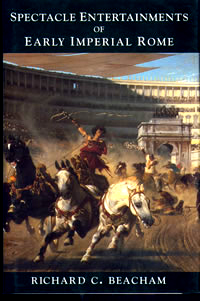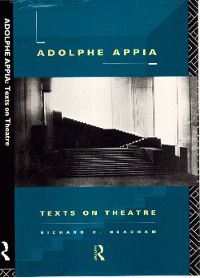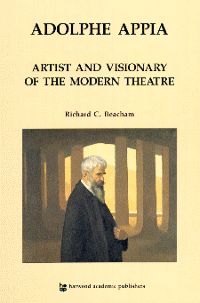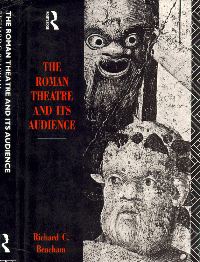|
Professor Richard Beacham - Book
publications
 |
|
Spectacle
Entertainments of Early Imperial Rome
The
presentation in the the theatre, gladiatorial combats, chariot
races in the circus, animal hunts, triumphal processions,
and other public entertainments of early imperial Rome served
as tangible expressions of Roman ideology and power. This
engagingly written book describes these lavish spectacles,
traces their evolution uner Rome's political masters from
Caesar to Nero, and discusses their social and political significance.
Drawing
on primary accounts of ancient historians as well as on archaeological
evidence, Richard C. Beacham examines the stagecraft of Roman
statecraft, providing illuminating accounts of such episodes
as the intensely theatrical rivalry of Caesar and Pompey,
Augustus's performance in what the Princeps himself called
the "mime of life" and the demented antics of Caligula.
He shows how Roman politicians and emperors created awesome
specacles of mass appeal in a potent exercise of demagoguery.
He argues that the Roman people in turn jealously gaurded
their right to be entertained, regarding the theatre, circus,
and arena as political venues in which to demonstrate their
power and vent their opinions.
|
 |
|
Adolphe
Appia: Artist and Visionary of the Modern Theatre
This
book is an account, analysis, and critical evaluation of the
work of the Swiss theatre designer and theorist, Adolphe Appia
(1862- 1928). Appia has long been recognised and revered as
the most important innovator in the concept and use of stage
lighting, but his imagination and work extended far beyond
this to embrace the fundamental reform of scenic design and
the use of theatrical space. Many of his ideas, which were
extremely advanced for his time, have now been widely accepted
and put into practice, but Appia has not received the credit
and attention he deserves, and much of his most important
work has been difficult to obtain in English. This book aims
to redress this balance, both by a close critical analysis
of his contribution to theatre and by providing directly relevant
examples from Appia's immensely important practical work,
placed in the context of his innovative theoretical writing.
|
 |
|
Adolphe
Appia: Artist and Visionary of the Modern Theatre
This
book is an account, analysis, and critical evaluation of the
work of the Swiss theatre designer and theorist, Adolphe Appia
(1862- 1928). Appia has long been recognised and revered as
the most important innovator in the concept and use of stage
lighting, but his imagination and work extended far beyond
this to embrace the fundamental reform of scenic design and
the use of theatrical space. Many of his ideas, which were
extremely advanced for his time, have now been widely accepted
and put into practice, but Appia has not received the credit
and attention he deserves, and much of his most important
work has been difficult to obtain in English. This book aims
to redress this balance, both by a close critical analysis
of his contribution to theatre and by providing directly relevant
examples from Appia's immensely important practical work,
placed in the context of his innovative theoretical writing.
|
 |
|
The
Roman Theatre and its Audience
Although
Roman drama, stagecraft, and theatre architecture have had
far greater influence upon the development of the modern theatre
than did the theatrical legacy of the Greeks, these subjects
have been relatively neglected by academic investigation and
discussion. This book traces the history of the Roman theatre--from
its origins in the fourth century BC to the demise of formal
theatrical activity at the end of antiquity--with the purpose
of identifying and describing that theatre's most important
characteristics and legacy.
A
major theme and focus of the study is the way in which the
Roman audience both influenced and reacted to the nature and
occasion of theatrical performance, and the insights which
this aspect contributes to our understanding of Roman stagecraft.
Dr. Beacham has himself translated Roman drama and produced
it for contemporary audiences upon a carefully researched
reconstruction of the type of temporary stage on which such
drama was first performed, and the book draws extensively
on his first-hand experience. As the work of a theatre historian
and theatre practitioner, it synthesizes and extends earlier
studies which have analysed the Roman theatre from the particular
perspectives of philology, literary criticism, or archaeology.
Its discussion of the vexed subject of Roman scenic practice
is particularly intriguing, as is its detailed account of
how a typical Roman comedy functions in performance.
|
<
back
|
|